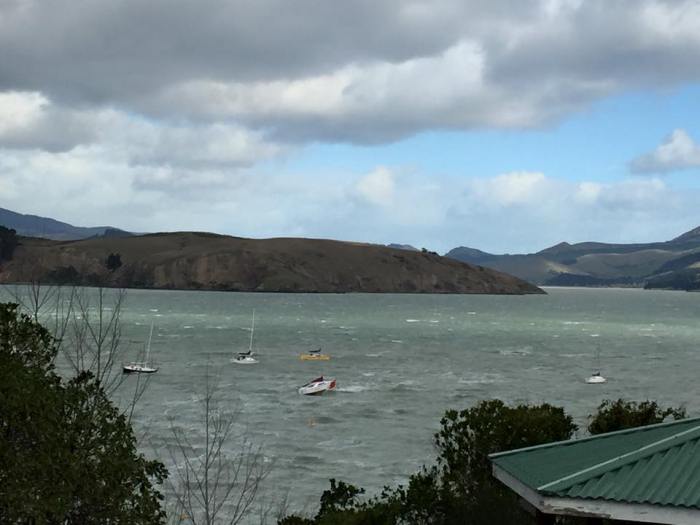Following on from last week’s post about the Atmosphere, at last night’s Meteorology lesson we learned all about Atmospheric moisture and clouds.
Clouds can give you big clues about reading the weather, so it is worth learning a bit more about them. So – how are clouds formed?
Moisture in the atmosphere can exist in three different states:
- Solid water – Ice
- Liquid water
- Water vapour
Latent heat is the extra energy required or released when the moisture changes from one state to another. The actual temperature of the substance doesn’t change, but it will warm or cool the surrounding environment depending on whether the latent heat is released or absorbed.
Warmer air is able to hold more water vapour than colder air. Relative Humidity is the ratio of the weight of water vapour in the air compared to the maximum weight of water vapour the same volume can actually hold (saturation point). This is expressed as a percentage.
You can see in my lovely diagram below how the same amount of water vapour is expressed as a % of the maximum possible at various different temperatures. While the amount of Water Vapour remains the same, the Relative Humidity % (in pink) changes as the temperature changes.
This is why it feels a lot wetter at the equator than it does at the poles.

When the relative humidity gets to 100% the air is said to have reached its Dew Point. If it cools beyond this, then the air can no longer hold any more moisture, so it condenses and forms in to Clouds.
To work out the relative humidity you can use the following formula:
Relative Humidity (%) = 100 – 5 x (difference between temperature & dew point)
So if the Temperature is 17º and the dew point is 10º
- 17º – 10º = 7
- 5 x 7 = 35
- 100 – 35 = 65
- = 65%
Stability
Stability refers to the vertical movement of air. Air that is stable will return to its original position after being disturbed by an external force. If it is unstable then it will continue to move away from its original position. If it is neutral then it will move to the new position and stop – not returning back to its original position nor moving further away.
Understanding stability means we can determine the kind of clouds we will get, the temperature and whether it will rain or not.

A Lapse Rate is the temperature decrease with a gain in height. We learned a bit about this last week when we were discussing the troposphere.
Ok here is where it gets a bit intense…
The Environmental Lapse Rate (ELR) is a variable rate that can change from day to day. On a standard day this rate could be a drop in temperature of 2ºC for every 1000ft of height.
The Dry Adiabatic Lapse Rate (DALR) is a fixed rate that does not change. Air that has less than 100% relative humidity is called dry air. Dry air warms and cools at 3ºC per 1000ft of height.
The Saturated Adiabatic Lapse Rate (SALR) is also a fixed rate that does not change. Saturated Air is air with more than 100% relative humidity. This air warms and cools at 1.5ºC per 1000ft of height.
When air rises, its pressure drops and it expands. The expansion requires energy so the temperature of the parcel of air decreases. This is called Adiabatic Cooling.
When air subsides, its pressure increases and it contracts. This contraction releases energy, causing its temperature to increase. This is called Adiabatic Warming.
When the Environmental Lapse Rate is less than the Dry Adiabatic Lapse Rate of 3º per 1000ft the air is said to be Stable. This is because the Environment stays warmer than the rising air. When the ELR is more than 3º the environment cools faster than the rising air and – this indicates instability as the air continues to rise.
When the ELR is less than the Saturated Adiabatic Lapse Rate of 1.5º, then the air is stable. When the ELR is greater than the SALR, the air is said to be unstable.
So in summary – the Environmental Lapse Rate is the rate that changes, and this air temperature determines whether any air being pushed over an obstacle (like a mountain) is stable or unstable.

As I write this, I am not sure on the clouds, but we have definitely reached our dew point, as the rain is pouring down and it sounds as though the roof is about to be lifted off by the wind. The Port Company has just registered 63kts on their anemometer and I expect I will be awake all night worrying about Wildwood on her mooring in the harbour. I just hope she is still there in the morning 😦
Tune in next time to learn more about what different clouds look like and what they can tell you about the weather.

Check out my other Meteorology Course posts here:
- Clouds
- Atmospheric Pressure
- Ocean Currents
- Tropical Revolving Storms
- Wind



Pingback: Meteorology – All about the Atmosphere | Astrolabe Sailing
Great stuff!
I still can’t decide which I dread most when it blows stink. Being on the boat (ready to save it, freaking from every howl of the wind and the ropes screeching), or being away from the boat (biting my finger nails to the bone)!
LikeLiked by 1 person
Agreed! Neither is particularly pleasant. The weather is so horrid that there is no way I could get out to her in the dinghy, and even if I could, then I wouldn’t be able to get on board, and if that happened, then I doubt I would be able to motor in to the wind, and if I could, I don’t know where i would go… so instead I will lay awake all night worrying about something I have no control of… 😦
LikeLiked by 1 person
It’ll be fine. Otherwise there wouldn’t be so many abandoned boats on moorings!
Our boats have all the TLC they can take!
LikeLike
Here’s one for you, Viki…100 degrees F and 100% humidity but there’s no rain in sight. We call that “the dog days of summer” in South Georgia!
LikeLike
Phew that’s hot! About 37 degrees C according to Google.
LikeLike
Pingback: Meteorology – Clouds | Astrolabe Sailing
Pingback: Meteorology – What about the wind…? | Astrolabe Sailing
Pingback: Meteorology – Tropical Revolving Storms | Astrolabe Sailing
Pingback: Meteorology – Weather Forecasts | Astrolabe Sailing